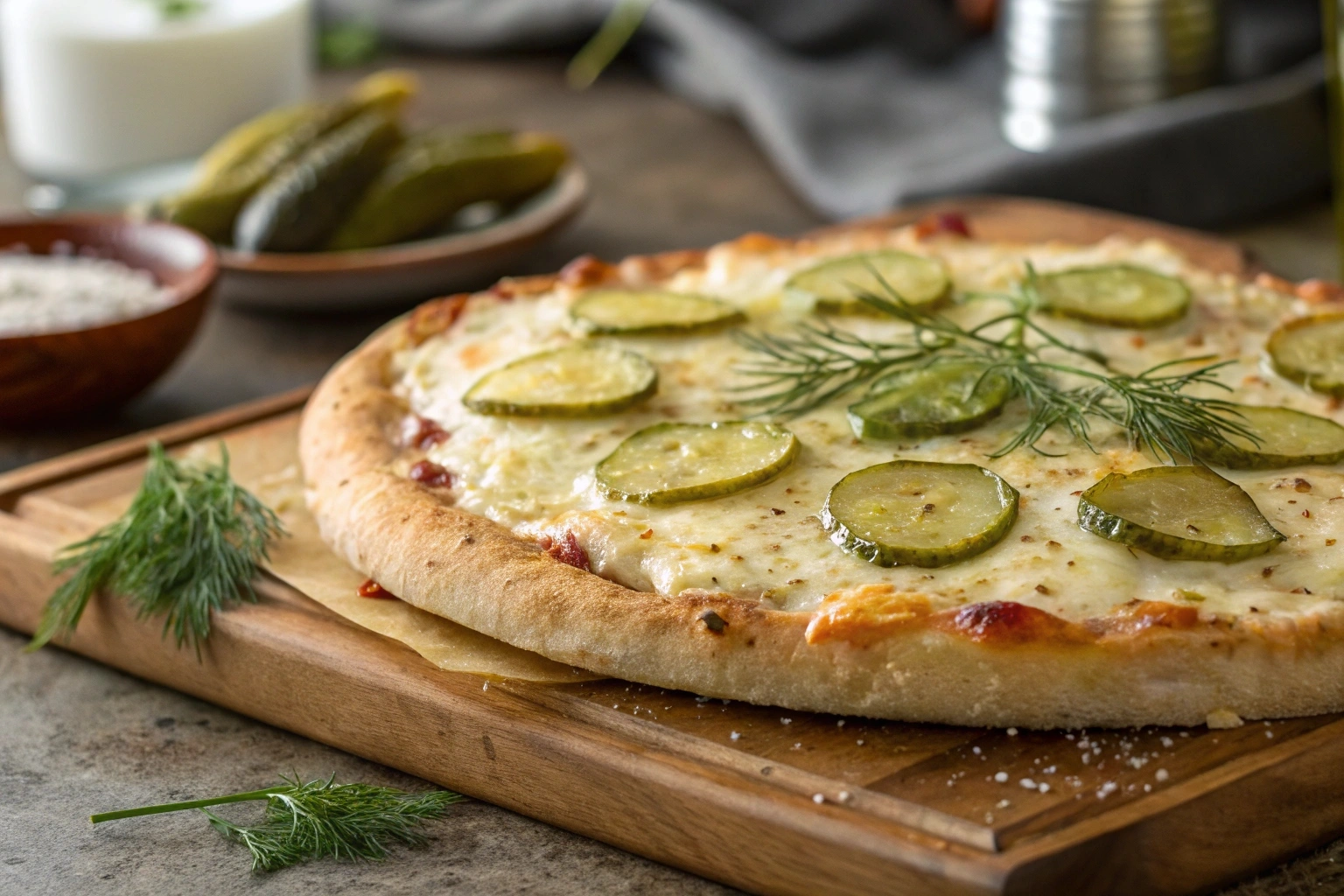
The Ultimate Pickle Pie Pizza: A Sweet, Spicy, and Tart Delight
Are you looking for an exciting dish that blends tangy, creamy, and savory flavors all in one bite? If so, you have come to the right place. This in-depth guide reveals how to create a unique Pickle Pie Pizza that replaces traditional tomato sauce with a smooth garlic-dill mixture and sprinkles on crunchy pickles for a bright kick. Indeed, this briny twist has gone from a novelty item at gourmet pizzerias to an at-home phenomenon. Therefore, get ready to learn every detail you need to craft this bold pizza variant in your own kitchen. By the time you finish reading, you will be ready to gather your ingredients and enjoy a memorable meal that appeals to both pickle lovers and those seeking a daring culinary adventure.
Why You Should Try This pickle pie pizza
Pickle Pie Pizza may sound unconventional. However, it has continued to gain a devoted following thanks to popular spots like QC Pizza, which introduced the “Kinda Big Dill,” and chef Ann Kim’s inventive pie. Thus, social media enthusiasts and food bloggers alike began raving about this tangy delight. On the other hand, some pizza purists expressed uncertainty at first. Eventually, many discovered that pairing the crunch of dill chips with gooey cheese and creamy sauce results in a harmonious balance of flavors.
In addition, the tanginess can cut through the richness of cheese, making each slice feel surprisingly light on the palate. Beyond the novelty factor, this Pickle Pie Pizza has practical advantages. For instance, you do not need to cook a separate tomato sauce, saving both time and effort. Moreover, the recipe can be customized to accommodate a broad range of dietary preferences. Therefore, if you are ready to depart from the norm and embark on a flavor-filled journey, keep reading for a comprehensive walkthrough.
The Inspiration and Evolution of pickle pie pizza
Where the Idea Originated
You might think that placing pickles on a pizza was a random invention, but it actually emerged from creative chefs who sought ways to stand out in a crowded dining scene. Because the pizza market is highly competitive, adding tangy dill slices offered a fresh point of differentiation. Viral social media posts showcased these pies, helping them gain traction among open-minded foodies. Therefore, what began as a niche concept rapidly evolved into a mainstream dish that continues to surprise first-timers.
Personal Anecdote: The First Bite
I remember the first time I tasted this tangy creation at a small pizzeria in Minnesota. I had always been a fan of pickles, so I was intrigued but cautious when reading “garlic-dill sauce” on the menu. However, the first bite introduced me to an incredible pop of flavor: the brine from the pickles melded seamlessly with the rich cheese and delicate crust. Thus, I found myself finishing slice after slice with no regret. Indeed, that memorable experience is what inspired me to replicate the dish at home and refine the recipe for anyone else eager to savor this intriguing combination.
Why the Flavors Work So Well
- Tangy and Crisp: The sharp taste and crunchy texture of pickles provide a lively contrast to smooth cheese.
- Creaminess: A garlic-dill sauce adds velvety richness in place of tomato-based sauce, bringing balance to the bite.
- Savory Punch: Low-moisture mozzarella, Parmesan, or Fontina supplies that salty note pizza lovers crave.
- Customizable: You can control how tangy or spicy you want the dish by picking different pickle varieties, adding red pepper flakes, or drizzling sweet honey.
On the other hand, those who prefer a bolder flavor can experiment with hot dill pickles or smoked cheeses. Therefore, there is plenty of room to tailor your pizza to match personal preferences.
Core Components and Their Functions
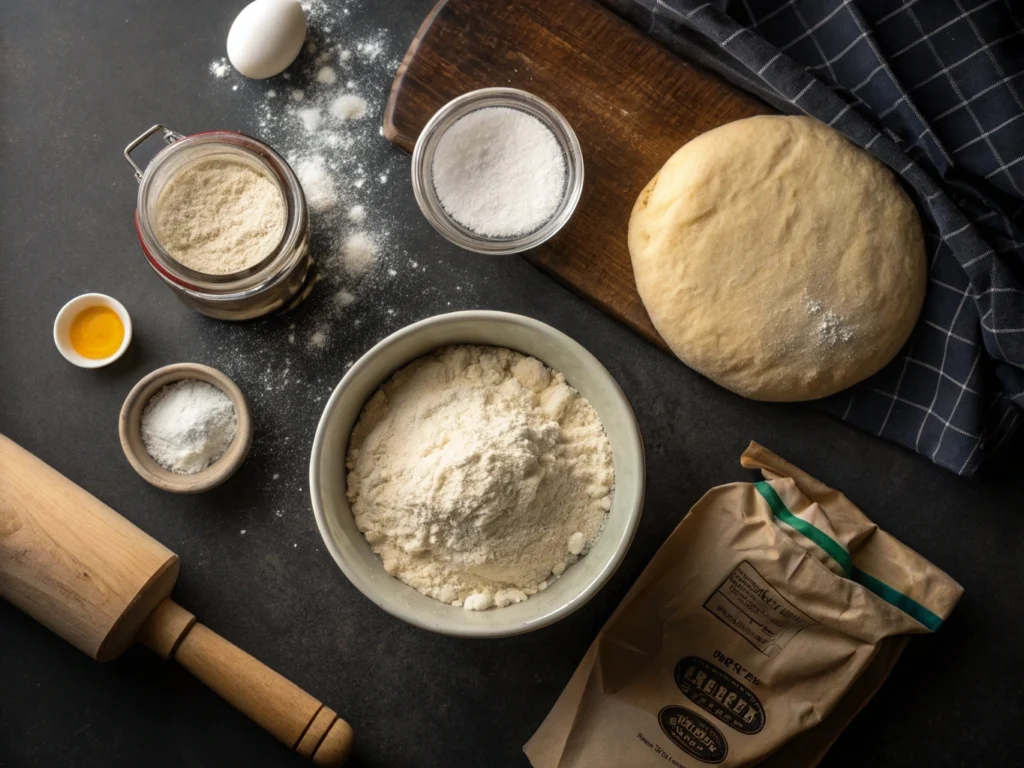
You do not need to be a gourmet chef to prepare this dish, especially once you know each element’s role. Thus, feel free to swap or tweak ingredients to suit your taste.
| Ingredient | Purpose | Notes/Variations |
|---|---|---|
| Crust Options | Forms the sturdy base for your toppings | – Homemade thin crust for freshness and a crisp bottom – Store-bought dough for speed – Puff pastry for a flaky, rich bite |
| Garlic-Dill Sauce | Replaces tomato sauce with a tangy, creamy layer | – Blend of sour cream, mayo, dill, garlic powder, pickle juice, salt, and pepper – Use your favorite ranch if you need a shortcut |
| Pickles | Adds brightness and crunchy texture | – Thinly sliced dill chips – Spicy pickles if you want extra heat – Pat them dry to prevent sogginess |
| Cheese | Provides the classic gooey, savory pizza element | – Low-moisture mozzarella – Parmesan or Fontina for a sharper bite – Smoked cheddar for a deeper flavor |
| Optional Toppings | Allows you to personalize flavor and texture | – Kettle chips, hot honey, fresh chives – Ham, Canadian bacon, or ground beef for protein |
Helpful Details About Your Key Ingredients
Crust Possibilities
- Homemade Dough
If you have an extra half-hour, a simple dough with flour, yeast (or sometimes no yeast), water, and salt can be quick and rewarding. Indeed, kneading dough can be therapeutic, and you can control the thickness or chewiness of your crust. - Store-Bought Dough
Pre-made dough saves time. It also ensures consistent results for beginners who might find yeast intimidating. However, let the dough rest at room temperature for about 20 minutes before shaping. Therefore, it becomes more pliable. - Puff Pastry
Are you in the mood for something different? In that case, puff pastry offers a flaky texture reminiscent of a cross between a classic pizza and a savory tart. Just be mindful of potential grease from the butter layers.
Sauce Secrets
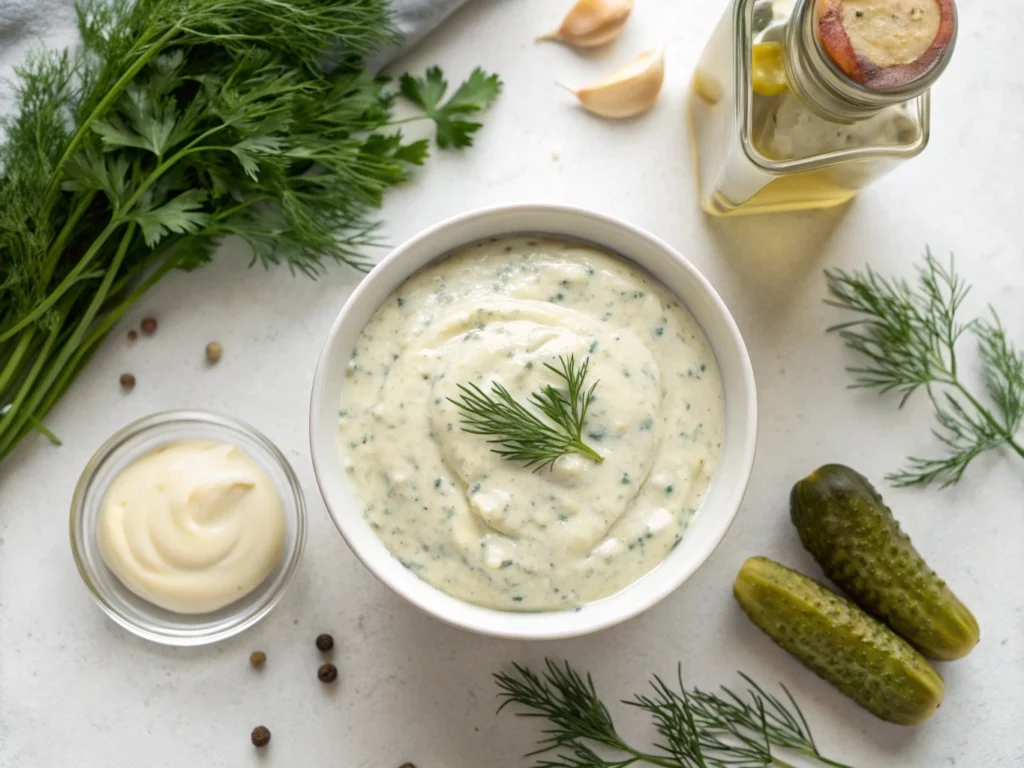
A garlic-dill sauce stands at the heart of this recipe. Thus, it is worth getting it right:
- Sour Cream and Mayonnaise
These add richness and a silky feel. However, you can switch to Greek yogurt for a lighter option if desired. - Pickle Juice
This brine not only thins the sauce but also infuses it with a punch of tang. On the other hand, you can reduce or omit it if you want milder acidity. - Fresh or Dried Dill
Dill is essential for that signature pickle flavor. If you have access to fresh dill, chop it finely and taste as you go, since fresh herbs can vary in intensity. - Spices
Garlic powder provides savory warmth. Meanwhile, a pinch of onion powder or smoked paprika can offer an extra layer of complexity. Therefore, do not be afraid to experiment in small amounts.
Choosing the Right Pickles
- Thin Slices
Slicing your pickles too thick could overwhelm each bite and make your Pickle Pie Pizza soggy. Consequently, thin slices create a balanced crunch that pairs well with the melted cheese. - Spicy vs. Mild
If you prefer a more intense flavor, look for brands like Mt. Olive Hot ‘N’ Spicy or Grillo’s Hot Pickles, both known for delivering a kick. - Drying Them Properly
Patting your pickles with a paper towel is key. Therefore, you reduce moisture and help ensure a crisp crust.
Cheese Varieties
While mozzarella remains a go-to, you might also consider combining cheeses. For instance, half mozzarella and half Fontina can give you a layered flavor. In addition, sprinkling a little Parmesan over the top can yield a lovely golden crust in the oven.
Potential Toppings
- Textural Elements: Crumbled kettle chips add a salty crunch.
- Colorful Herbs: Fresh chives or scallions bring a pop of green.
- Sweet Contrast: Drizzling hot honey can offset any strong tang.
- Protein: If you want added heft, diced ham or bacon bits can round out the meal.
Step-by-Step Preparation: From Dough to Delicious
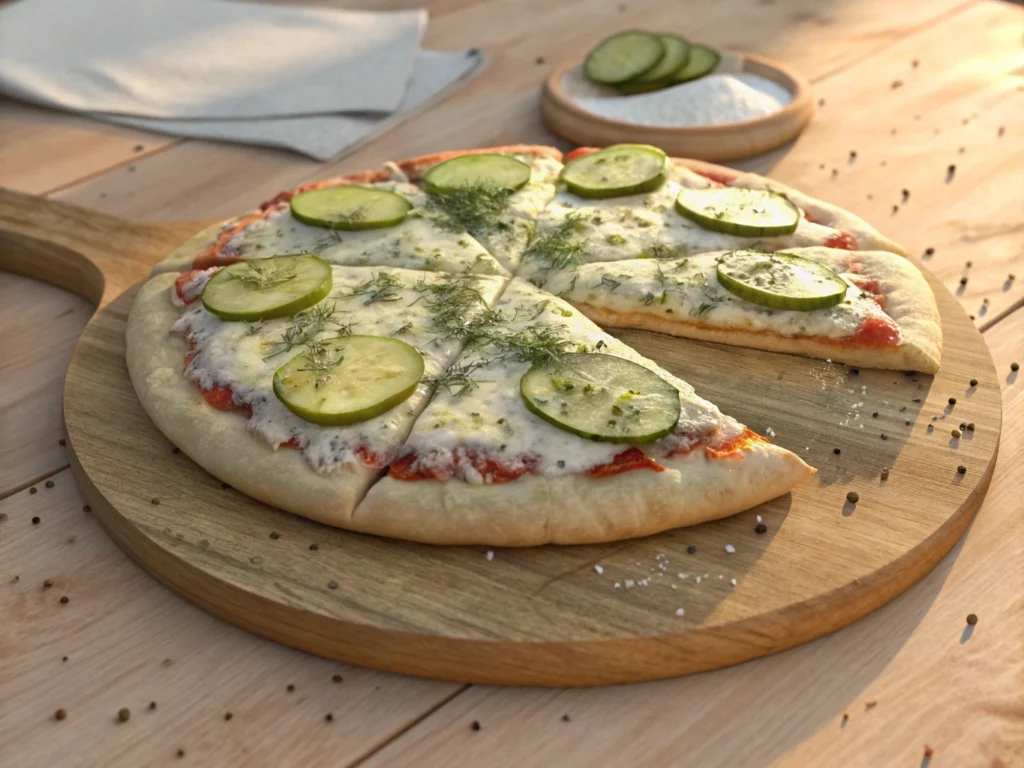
It is always easier to tackle a new recipe when you break it down into steps. Therefore, follow this timeline, and you will soon have a steaming, tangy pie on your table.
1. Gather Your Tools and Preheat
- Crank Up the Heat
Set your oven to 500°F (or its highest setting). A piping-hot oven helps achieve a crisp crust. In addition, if you own a pizza stone or steel, place it inside to preheat. - Prepare a Peel or Baking Sheet
Dust a pizza peel or a large cutting board with cornmeal, or use parchment paper to prevent sticking. However, if you do not have these on hand, a flat baking sheet can serve as a makeshift peel.
2. Whisk the Sauce
- Combine in a Bowl
Mix sour cream, mayonnaise, pickle juice, dill, garlic powder, salt, and pepper. Because you want a smooth blend, whisk until there are no lumps. - Taste and Adjust
If it tastes too briny, add a bit more mayo. On the other hand, if you need more zip, add a few more drops of pickle juice or a pinch of acid like lemon juice. - Refrigerate
Chilling the sauce for about 10–15 minutes can help the flavors meld. Thus, you end up with a more cohesive taste.
3. Shape the Crust
- Room-Temperature Dough
If using store-bought dough, let it rest out of the fridge for 20 minutes. This makes it easier to stretch. - Roll It Out
Flour your work surface. Then, use a rolling pin or stretch the dough with your hands to a diameter of 12–14 inches, depending on how thin you prefer your crust. - Transfer
Place the shaped dough onto the dusted peel or your chosen parchment paper. Therefore, you avoid the dough sticking and forming holes when you move it to the oven.
4. Spread the Sauce and Layer Toppings
- Sauce Base
Use a spoon to add the garlic-dill sauce, leaving about 1 inch of uncovered crust around the edge. - Cheese
Distribute your cheese of choice over the sauce. In addition, consider sprinkling a small handful of cheese over the exposed crust if you like a browned edge. - Pickle Placement
Arrange your dill slices evenly. In addition, some people place a few pickles under the cheese for a layered effect. - Optional Additions
- Red pepper flakes
- Kettle chips
- Cooked ground beef or diced ham
5. Slide into the Oven
- Transfer to Stone or Steel
Carefully slide the pizza off your peel or baking sheet onto the preheated surface. Alternatively, you can place it on a hot baking tray if that is your only option. - Baking Time
Keep a close eye on your Pickle Pie Pizza. Generally, it will be done in about 11–13 minutes. However, ovens vary, so watch for bubbling cheese and a golden crust. - Optional Broil
For extra browning, turn the broiler on for the final 1–2 minutes. Thus, you get a crisp, slightly charred edge. Be vigilant, though, because the crust can burn quickly under intense heat.
6. Final Touches
- Drizzle or Dust
Once your Pickle Pie Pizza is out of the oven, you may drizzle hot honey or sprinkle chopped chives, fresh dill, or grated Parmesan on top. Consequently, these final accents heighten color and flavor. - Rest and Slice
Let the Pickle Pie Pizza sit for about 3–5 minutes. That way, the cheese can set. Then, slice into wedges and serve.
Serving Suggestions and Approximate Nutrition
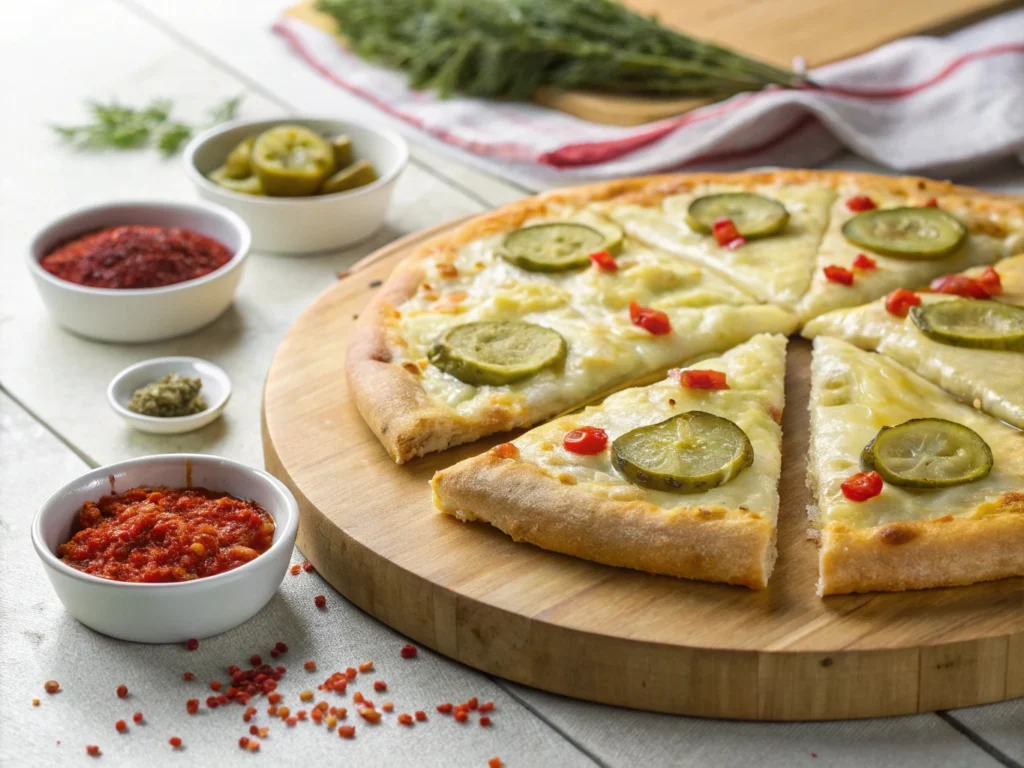
Serving the Finished Pie
- Main Course or Shareable
This tangy creation can be an impressive centerpiece at a casual dinner party or a fun family meal. Therefore, serve large slices for an entrée or cut them smaller for an appetizer. - Suggested Sides
Because the Pickle Pie Pizza is quite rich and tangy, you might pair it with a light salad or crisp veggie dish. In addition, consider a coleslaw that includes chopped pickles for a double dose of brine.
Nutritional Overview
Exact calorie counts differ based on the crust, toppings, and cheese amounts you use. However, here is a ballpark per average slice of a 12-inch pizza:
- Calories: 300–350
- Fat: ~10–15g
- Carbs: ~35–40g
- Protein: 12–15g
- Sodium: Higher than some pizzas (due to pickles and cheese), so be mindful if you watch salt intake.
For precise calculations, you could use a reliable nutrition database, such as MyFitnessPal or the USDA FoodData Central. Thus, you can adjust ingredient amounts to fit dietary needs.
Troubleshooting and Variations
Even the most experienced cook can run into issues. Therefore, here are a few ways to overcome common hurdles.
Common Pitfalls
- Soggy Crust
- Insufficiently preheated oven or stone
- Using thick pickle slices or not drying them
- Overloading sauce or cheese
- Overly Tangy
- Use fewer pickles or try bread-and-butter pickles
- Reduce the pickle juice in your sauce
- Balance the acidity with a sweet drizzle, such as honey or a mild barbecue sauce
- Underseasoned Sauce
- Be sure to taste your sauce and adjust salt or dill
- Enhance flavors with a pinch of onion powder or a dash of chili flakes
Ingredient Swaps
- Gluten-Free Crust: Many brands now offer GF doughs, or you can make your own using a mix of rice flour, tapioca starch, and other binders.
- Vegan Cheese: Plant-based cheeses have come a long way in texture and taste. In addition, vegan mayo can replace standard mayo in the sauce.
- Protein Boost: Cooked chicken, bacon, or ground beef can turn your pizza into a hearty meal. On the other hand, tofu or vegan sausage works for those avoiding meat.
Creative Flavor Boosts
- Add Fresh Herbs: Toss some basil or oregano over the baked pizza for extra aroma.
- Spicy Twist: Scatter pickled jalapeños or banana peppers on top.
- Sweet & Salty: Drizzle maple syrup if you prefer a sweeter note, balancing the brine from the pickles.
Beyond Pizza: More Pickle-Focused Creations
If you love the briny flavor that pickles bring, you will be excited to know there are numerous ways to incorporate them into your cooking routine. Therefore, explore the following ideas to satisfy your tangy cravings.
- Fried Pickles with Creamy Dip
- Lightly bread dill slices and fry them for a crunchy snack.
- Serve with ranch dressing or the leftover garlic-dill sauce.
- Cheeseburger Pizza with Pickle Relish
- Merge two fast-food favorites by adding ground beef, cheddar, and a special sauce that includes relish.
- Consider toasting sesame seeds on the crust for a hamburger bun vibe.
- Creamy Pickle Slaw
- Stir chopped pickles into a coleslaw mix.
- Dress with a blend of mayonnaise, vinegar, sugar, and dill for a tangy, crunchy side.
- Chicago-Style Hot Dogs
- Pile on mustard, onions, tomatoes, a pickle spear, and sport peppers.
- Avoid adding ketchup if you want an authentic approach, but feel free to adapt to your taste.
- Pickle-Brined Fried Chicken
- Let your chicken soak in pickle juice for a few hours or overnight.
- Coat and fry as usual for a tender, flavorful bite.
In-Depth Tips for Perfecting Your Pickle Pie Pizza
Although we have covered the main steps, a few extra pointers can help you achieve pizzeria-quality results at home:
- Use High-Heat Methods
Because you want a crust that is both airy and crisp, baking at a very high temperature is essential. Thus, do not hesitate to crank your oven to its highest safe setting. - Top Variation
Think of the cheese as a shield for the dough. Adding pickles on top of the cheese can help them roast slightly, but tucking a few under can keep them juicy. Consequently, you get multiple layers of texture in each bite. - Timing the Bake
If you add more toppings like meat or extra cheese, the pizza might need a bit more time. However, remain vigilant since high-heat baking can go from perfect to burnt in less than a minute. - Test Small Batches
If you are uncertain about certain flavors, try making a personal-size pizza or even a flatbread. That way, you can test if you like the ratio of sauce to pickles before committing to a full pie. - Don’t Drown the Crust
Spread the sauce lightly. Therefore, you avoid overwhelming the pizza with too much moisture. You can always serve extra sauce on the side for dipping.
Flavor Pairings and Serving Occasions
Balanced Beverages
- Crisp Lager: Beer with a clean finish pairs well with tangy bites.
- Light White Wine: Sauvignon Blanc or Pinot Grigio can highlight the pickle’s acidity without clashing.
- Sparkling Water: A citrus-infused sparkling water can also cleanse your palate between slices.
Festive Events and Gatherings
- Game Day: Combine this pizza with fried pickles or buffalo wings for a memorable sports-watching spread.
- Pickle-Themed Parties: Yes, they exist! Serve pickle dips, relishes, and chips for a complete brine-inspired table.
- Casual Dinners: Because the recipe is so straightforward, it can become your go-to quick dinner when you crave something different yet comforting.
Expanding Your Pickle Horizons
Although we have focused on how pickles enhance pizza, do not stop there. Indeed, pickles can elevate everything from sandwiches to soups. Thus, consider these ideas the next time you find yourself craving the tang of vinegar and dill:
- Pickle-Infused Salad Dressings
Substitute part of the vinegar or lemon juice in your standard vinaigrette with pickle brine for a bright twist. - Pickle Salsa
Chop pickles, onions, tomatoes, and jalapeños. Then, mix them with lime juice and a dash of cilantro. Serve this mix with tortilla chips for a tangy alternative to pico de gallo. - Pickle Pasta Salad
Stir chopped pickles into a creamy macaroni salad. On the other hand, you can slice them into a cold orzo salad with a light, dill-forward dressing. - Pickle Martinis
Mix gin or vodka with pickle juice in place of olive brine. Garnish with a pickle spear instead of an olive.
Each of these ideas builds on the same love of tangy flavors that draw people to pickled ingredients. Therefore, if you find yourself unable to get enough of that briny taste, you can keep exploring new uses with ease.
Frequently Asked Questions
1. Can I Use Sweet Gherkins on This Pizza?
Yes, you absolutely can. In fact, many people enjoy the sweeter bite as it reduces overall tang. Therefore, if you find standard dill too sharp, try bread-and-butter pickles or gherkins. Just be sure to monitor the sauce, as you may need less pickle juice to avoid an overly sweet result.
2. What If I Do Not Have a Pizza Stone or Steel?
A regular baking sheet works fine. However, you should preheat it in the oven for a few minutes before placing your dough on top. Thus, you can mimic the effect of a hot stone and get a crisp bottom. If sticking is a concern, line the sheet with parchment paper for an easy cleanup.
3. How Do I Keep My Pizza from Becoming Oversalted?
Pickles and cheese both contribute saltiness. On the other hand, you can choose low-sodium cheese varieties and rinse your pickles if you want to reduce sodium. Alternatively, limit the extra salt in your sauce or consider balancing with a sweet drizzle at the end.
4. Can I Freeze Leftover Pizza?
While it is possible to freeze leftover slices, the pickles may become softer upon thawing. Therefore, if your schedule allows, freeze just the dough and sauce separately. Then, add fresh pickles on baking day. However, if you must freeze the entire pizza, reheat it in a hot oven or air fryer for best texture.
5. How Should I Reheat Leftovers?
Reheating in a conventional or toaster oven at 375°F is a safe bet. Let it heat for around 5–7 minutes until the cheese is melted and the crust is crisp. Indeed, try to avoid microwaving, since it can result in a chewy, less appealing texture.
6. Are There Any Healthy Tweaks I Can Make?
Use Greek yogurt instead of mayo or sour cream in the sauce. Also, opt for whole-grain or cauliflower crust if you want more fiber and nutrients. Finally, load up on veggies like onions, peppers, or mushrooms to increase the nutritional profile.
7. Do I Need Fresh Dill for the Sauce?
No, dried dill works well and often has a concentrated flavor. Therefore, start with a teaspoon or two, and then adjust based on your taste. If you do have fresh dill, chop it finely, and note that you might need a bit more than dried to achieve the same flavor.
Conclusion
By now, you have learned how to make a memorable tangy pizza that combines creamy garlic-dill sauce, crisp pickles, and melty cheese on a perfectly crisp crust. In addition, you have discovered how easy it is to swap ingredients and tailor the recipe to your dietary needs. Therefore, there is no reason to let skepticism hold you back from experiencing a lively twist on everyone’s favorite comfort food.
